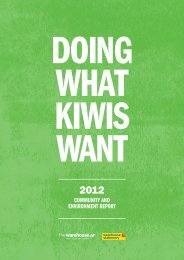ar11-lr-final
Create successful ePaper yourself
Turn your PDF publications into a flip-book with our unique Google optimized e-Paper software.
Statements of Changes in Equity<br />
For the 52 WEEK period ended 31 July 2011<br />
GROUP<br />
SHARE<br />
CAPITAL<br />
TREASURY<br />
STOCK<br />
CASH FLOW<br />
HEDGE<br />
RESERVE<br />
EMPLOYEE<br />
SHARE<br />
BENEFITS<br />
RESERVE<br />
RETAINED<br />
EARNINGS<br />
MINORITY<br />
INTEREST<br />
TOTAL<br />
EQUITY<br />
$000 $000 $000 $000 $000 $000 $000<br />
For the 52 week period ended 31 July 2011<br />
Balance at the beginning of the period 251,445 (8,262) (4,007) 3,422 60,308 340 303,246<br />
Net profit for the period – – – – 77,829 316 78,145<br />
Net change in fair value of cash flow hedges – – (20,097) – – – (20,097)<br />
Total comprehensive income (20,097) – 77,829 316 58,048<br />
Share based payments charged to the<br />
income statement<br />
– – – 1,640 – – 1,640<br />
Share rights exercised – 2,110 – (2,250) 140 – –<br />
Dividends paid – – – – (90,246) (331) (90,577)<br />
Treasury stock dividends received – – – – 416 – 416<br />
Purchase of treasury stock – (1,233) – – – – (1,233)<br />
Balance at the end of the period 251,445 (7,385) (24,104) 2,812 48,447 325 271,540<br />
(note: 30) (note: 30) (note: 31) (note: 31) (note: 33) (note: 32)<br />
For the 52 week period ended 1 August 2010<br />
Balance at the beginning of the period 251,445 (14,356) (20,737) 3,654 100,887 251 321,144<br />
Profit for the period – – – – 60,185 355 60,540<br />
Net change in fair value of cash flow hedges – – 16,730 – – – 16,730<br />
Total comprehensive income – – 16,730 – 60,185 355 77,270<br />
Notes to and forming part of the Financial Statements<br />
For the 52 WEEK period ended 31 July 2011<br />
1. Summary Of Accounting Policies<br />
These financial statements have been prepared in accordance with New Zealand Generally Accepted Accounting Practice and<br />
New Zealand Equivalents to International Financial Reporting Standards (NZ IFRS). The financial statements also comply with<br />
International Financial Reporting Standards (IFRS). The principal accounting policies adopted in the preparation of the financial<br />
report are set out below. These policies have been consistently applied to all the years presented, unless otherwise stated.<br />
The financial report includes separate financial statements for The Warehouse Group Limited (the “Parent”) as an individual entity<br />
and the consolidated entity consisting of The Warehouse Group Limited and its subsidiaries (together the “Group”).<br />
Reporting entity<br />
The Warehouse Group Limited is a company registered under the New Zealand Companies Act 1993 and is listed on the New Zealand<br />
and Australian stock exchanges. The Warehouse Group Limited is an issuer for the purposes of the New Zealand Financial Reporting<br />
Act 1993. The Group is designated as a profit oriented entity for financial reporting purposes. The consolidated financial statements<br />
of The Warehouse Group Limited have been prepared in accordance with the New Zealand Companies Act 1993 and New Zealand<br />
Financial Reporting Act 1993.<br />
Functional and presentation currency<br />
Items included in the Financial Statements of each of the Group’s operations are measured using the currency of the primary<br />
economic environment in which the entity operates (“functional currency”). The financial statements are presented in New Zealand<br />
dollars, which is the Parent’s functional and the Group’s presentation currency. The New Zealand dollar amounts presented in these<br />
financial statements are rounded to the nearest thousands, unless otherwise stated. Ordinary shares and share rights disclosures<br />
are also rounded to the nearest thousands.<br />
Reporting period<br />
The Group has reported its full year result on a 52 week basis. The current year represents the 52 week period commencing 2 August 2010<br />
to 31 July 2011. The prior full year comparative represents the 52 week period commencing 3 August 2009 to 1 August 2010.<br />
Share based payments charged to the<br />
income statement<br />
– – – 2,609 – – 2,609<br />
Share rights exercised – 1,751 – (2,471) 720 – –<br />
Shares issued to employee share purchase plan – 4,355 – (370) (1,285) – 2,700<br />
Dividends paid – – – – (101,139) (266) (101,405)<br />
Treasury stock dividends received – – – – 940 – 940<br />
Purchase of treasury stock – (12) – – – – (12)<br />
Balance at the end of the period 251,445 (8,262) (4,007) 3,422 60,308 340 303,246<br />
(note: 30) (note: 30) (note: 31) (note: 31) (note: 33) (note: 32)<br />
PARENT<br />
SHARE<br />
CAPITAL<br />
RETAINED<br />
EARNINGS<br />
TOTAL<br />
EQUITY<br />
$000 $000 $000<br />
For the 52 week period ended 31 July 2011<br />
Balance at the beginning of the period 251,445 10,884 262,329<br />
Total comprehensive income – 90,244 90,244<br />
Dividends paid – (90,246) (90,246)<br />
Balance at the end of the period 251,445 10,882 262,327<br />
(note: 30) (note: 33)<br />
For the 52 week period ended 1 August 2010<br />
Balance at the beginning of the period 251,445 10,886 262,331<br />
Total comprehensive income – 101,137 101,137<br />
Dividends paid – (101,139) (101,139)<br />
Balance at the end of the period 251,445 10,884 262,329<br />
(note: 30) (note: 33)<br />
Historical cost convention<br />
These financial statements have been prepared under the<br />
historical cost convention, as modified by the revaluation of<br />
financial assets and liabilities (including derivative instruments)<br />
at fair value through the income statement.<br />
(a) Basis of consolidation<br />
The consolidated financial statements include the parent<br />
company and its subsidiaries and associates.<br />
Subsidiaries are all those entities (including special purpose<br />
entities) over which the Group has the power to govern the<br />
financial and operating policies, generally accompanying a<br />
shareholding of more than one half of the voting rights. The<br />
existence and effect of potential voting rights that are currently<br />
exercisable or convertible are considered when assessing<br />
whether the Group controls another entity.<br />
The purchase method of accounting is used to account<br />
for the acquisition of subsidiaries by the Group. The<br />
acquisition consideration is measured as the fair value of<br />
the assets acquired, equity interest issued and liabilities<br />
incurred or assumed at the acquisition date. The excess<br />
of the consideration transferred above the fair value of the<br />
identifiable net assets acquired is recognised as goodwill. If<br />
the consideration is less than the fair value of the net assets<br />
acquired, the difference is recognised directly in the Income<br />
Statement.<br />
Subsidiaries are fully consolidated from the date on which<br />
control is transferred to the Group, and are de-consolidated from<br />
the date that control ceases.<br />
Intercompany transactions, balances and unrealised gains on<br />
transactions between Group companies are eliminated.<br />
(b) Associates<br />
Associates are all entities over which the Group has significant<br />
influence but not control, generally accompanying a shareholding<br />
of between 20% and 50% of the voting rights. Associates have<br />
been recorded in the consolidated financial statements on an<br />
equity accounting basis, which recognises the Group’s share<br />
of retained surpluses in the income statement and its share<br />
of post acquisition increases or decreases in net assets in the<br />
balance sheet.<br />
(c) Statement of cash flows<br />
The following definitions are used in the statement of cash<br />
flows:<br />
• Operating activities are principal revenue producing activities<br />
of the Group that are not investing or financing activities.<br />
• Investing activities are those activities relating to the<br />
acquisition, holding and disposal of property, plant and<br />
equipment and of investments.<br />
• Financing activities are those activities that result in changes<br />
in the size and composition of the capital structure. This<br />
includes both equity and borrowings not falling within the<br />
definition of cash. Dividends paid in relation to the capital<br />
structure are included in financing activities.<br />
• Cash comprises cash on hand and in transit, bank in funds<br />
and short term deposits offset by bank overdrafts.<br />
• Cash flows relating to current and non-current borrowings<br />
are presented as net cash flows as gross cash inflows and<br />
outflows include day-to-day cash management.<br />
The accompanying statement of accounting policies and notes to the financial statements on pages 35 to 74 form an integral part of the financial statements.<br />
FINANCIAL STATEMENTS 34<br />
FINANCIAL STATEMENTS 35
















